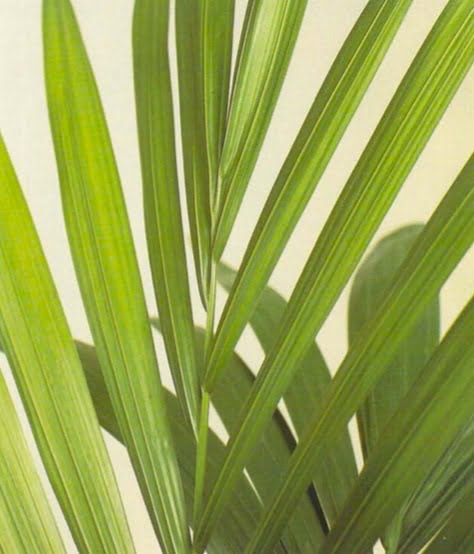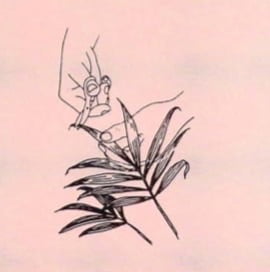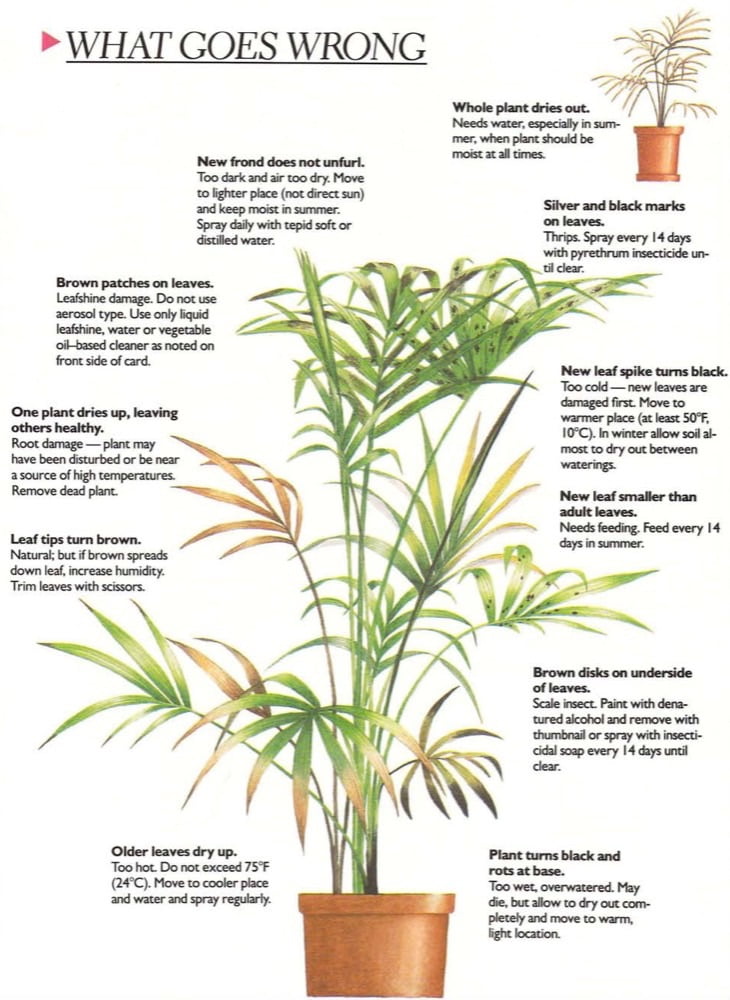[Ebook Việt Hoá] The Instant Guide to Healthy Houseplants (Hướng dẫn tức thời để chăm cây trong nhà khoẻ mạnh), Chi Howea
[Ebook Việt Hoá] The Instant Guide to Healthy Houseplants: Howea forsteriana (Paradise palm, Sentry palm, Kentia palm, Thatch-leaf palm)
- Nguồn: [Ebook Việt Hoá] The Instant Guide to Healthy Houseplants (Hướng dẫn tức thời để chăm cây trong nhà khoẻ mạnh)
- Biên tập: Dũng Cá Xinh
- Biên dịch: Team Codai.net
English
Named after the Lord Howe Islands but sometimes called Kentia forsteriana, this is the “Victorian” palm associated with palm courts. It is a wonderful, decorative accent for an office or home. Mature specimens can grow to 12 feet (nearly 4 m) in the home. As H. forsteriana is very slow-growing, producing one leaf per plant per year, it is usually planted three or four to a pot. It is extremely tolerant of various light conditions and will survive in a dark location for a long time. It is very susceptible to root damage if knocked over, so treat it with care.

Light
Prefers indirect daylight but survives quite well in artificial light.
Temperature
Winter minimum, 50°F(10°C); summer maximum, 75°F (24°C).
Water
In summer, keep just moist at all times, watering once or twice a week. In winter, water once every week or ten days, allowing almost to dry out in between.
Humidity
Spray daily with fine mist of tepid soft or distilled water in summer, especially if 75°F (24°C) or over.
Feeding
Every 14 days in summer, feed with houseplant food diluted with water according to manufacturer’s instructions.
Soil
Use fibrous mixture of 4 parts loam, 1 part sedge or peat moss, 1 part rotted compost.
Repotting
In spring, only if plant is potbound, place into pot one size larger. With younger plant, knock from its pot very carefully, making sure root-ball does not crumble or the individual plants separate. Do not repot large, mature plants; just change topsoil.
Cleaning
Wipe every week with damp cloth. Use vegetable-oil cleaner, 6-7 drops of milk in a cup of soft water or liquid leaf- shine diluted in water (make it 4 times weaker than the manufacturer’s recommended strength). Use no aerosol leafshine.
Trimming fronds and leaves
Cut off dead lower fronds as close to main stem as possible. If the tips of the leaves are brown and dry, trim them with sharp scissors, cutting just outside healthy leaf tissue.

What Goes Wrong

- New frond does not unfurl: Too dark and air too dry. Move to lighter place (not direct sun) and keep moist in summer. Spray daily with tepid soft or distilled water.
- Brown patches on leaves: Leafshine damage. Do not use aerosol type. Use only liquid leafshine, water or vegetable oil-based cleaner as noted on front side of card.
- One plant dries up, leaving others healthy: Root damage plant may have been disturbed or be near a source of high temperatures. Remove dead plant.
- Whole plant dries out: Needs water, especially in summer, when plant should be moist at all times.
- Silver and black marks on leaves: Thrips. Spray every 14 days with pyrethrum insecticide until clear.
- New leaf spike turns black: Too cold new leaves are damaged first. Move to warmer place (at least 50°F – 10°C). In winter allow soil almost to dry out between waterings.
- New leaf smaller than adult leaves: Needs feeding. Feed every 14 days in summer.
- Brown disks on underside of leaves: Scale insect, paint with denatured alcohol and remove with thumbnail or spray with insecticidal soap every 14 days until clear.
- Plant turns black and rots at base: Too wet, overwatered. May die, but allow to dry out completely and move to warm, light location.
- Leaf tips turn brown. Natural; but if brown spreads down leaf, increase humidity. Trim leaves with scissors.
- Older leaves dry up: Too hot. Do not exceed 75°F (24°C). Move to cooler place and water and spray regularly.
Tiếng Việt
Được đặt theo tên của Quần đảo Lord Howe nhưng đôi khi được gọi là Kentia forsteriana, đây là loài cọ “thời Victoria” gắn liền với các sân cọ. Nó là một điểm nhấn tuyệt vời cho văn phòng hoặc nhà ở. Các cây trưởng thành có thể phát triển đến 12 feet (gần 4 m) trong nhà. Vì H. forsteriana phát triển rất chậm, hàng năm chỉ cho mỗi cây một lá, nó thường được trồng ba hoặc bốn cây cùng một chậu. Nó có khả năng chịu đựng tốt trong các điều kiện ánh sáng khác nhau và sẽ tồn tại một thời gian dài trong bóng tối. Cây rất dễ bị tổn thương rễ nếu bị đổ, vì vậy hãy xử lý cẩn thận.

Ánh sáng
Thích ánh sáng ban ngày gián tiếp nhưng thích nghi khá tốt trong ánh sáng nhân tạo.
Nhiệt độ
Mùa đông tối thiểu là 50 ° F (10 ° C); tối đa mùa hè khoảng 75 ° F (24 ° C).
Nước
Vào mùa hè, chỉ cần giữ ẩm mọi lúc, tưới một hoặc hai lần một tuần. Vào mùa đông, tưới nước mỗi tuần hoặc mười ngày một lần, để cho cây gần như khô ở giữa.
Độ ẩm
Xịt hàng ngày với sương mềm hoặc nước cất vào mùa hè, đặc biệt nếu 75 ° F (24 ° C) trở lên.
Bón phân
Cứ 14 ngày trong mùa hè, sử dụng phân bón hữu cơ pha loãng theo hướng dẫn của nhà sản xuất.
Đất
Sử dụng hỗn hợp dạng sợi gồm 4 phần đất thịt, 1 phần cói hoặc than bùn, 1 phần phân đã mục nát.
Thay chậu
Vào mùa xuân, chỉ khi cây được trồng trong chậu, hãy chuyển vào chậu có kích thước lớn hơn. Với cây non, hãy gõ thật cẩn thận từ chậu của nó, đảm bảo rễ cây không bị gãy hoặc các cây riêng lẻ tách rời nhau. Không thay chậu cho cây lớn, trưởng thành; chỉ thay đổi lớp đất mặt.
Làm sạch
Lau sạch hàng tuần bằng khăn ẩm. Sử dụng chất tẩy rửa từ dầu thực vật, nhỏ 6-7 giọt sữa vào một cốc nước mềm hoặc dung dịch làm bóng lá pha loãng trong nước (làm cho nó loãng hơn 4 lần so với độ đậm đặc khuyến nghị của nhà sản xuất). Không sử dụng xịt bóng lá.
Cắt tỉa lá
Cắt bỏ những lá chết phía dưới càng gần thân chính càng tốt. Nếu đầu lá có màu nâu và khô, hãy cắt tỉa bằng kéo sắc, cắt ngay phần mô lá khỏe mạnh bên ngoài.

Những vấn đề có thể xảy ra

- Không ra lá mới: Quá tối và không khí quá khô. Di chuyển đến nơi sáng hơn (không nắng trực tiếp) và giữ ẩm vào mùa hè. Xịt hàng ngày bằng nước mềm hoặc nước cất.
- Các mảng màu nâu trên lá: Hư hại do xịt bóng lá. Không sử dụng loại bình xịt. Chỉ sử dụng dung dịch làm bóng lá dạng lỏng, nước hoặc dầu thực vật như đã ghi ở mặt trước.
- Một cây khô héo, những cây khác khỏe mạnh: Cây bị hại có thể do rễ đã bị xáo trộn hoặc ở gần nguồn nhiệt độ cao. Loại bỏ cây chết.
- Toàn bộ cây bị khô: Cần nước. Đặc biệt là vào mùa hè, cây phải luôn ẩm.
- Vết đen bạc trên lá: Bọ cánh viền. Phun thuốc trừ sâu pyrethrum 14 ngày một lần cho đến khi khỏi bệnh.
- Cành lá mới chuyển sang màu đen: Lạnh quá lá mới bị hư. Di chuyển đến nơi ấm hơn (ít nhất 50 ° F – 10 ° C). Vào mùa đông, đất gần như khô đi giữa các lần tưới.
- Lá mới nhỏ hơn lá trưởng thành: Cần bón phân 14 ngày một lần vào mùa hè.
- Vết tròn nâu ở mặt dưới lá: Rệp vảy, dùng cồn biến tính và tẩy vết tròn nhỏ hoặc phun xà phòng diệt côn trùng 14 ngày một lần cho đến khi sạch.
- Cây chuyển sang màu đen và thối ở gốc: Quá ẩm ướt, tưới quá nhiều. Có thể chết, nhưng để khô hoàn toàn và di chuyển đến vị trí ấm hơn, có ánh sáng.
- Đầu lá chuyển sang màu nâu: Tự nhiên; nhưng nếu màu nâu lan xuống lá làm tăng độ ẩm. Dùng kéo cắt tỉa lá.
- Những lá già khô héo: Quá nóng. Không vượt quá 75 ° F (24 ° C). Di chuyển đến nơi mát mẻ và tưới nước thường xuyên hơn.
![[Ebook Việt Hoá] The Instant Guide to Healthy Houseplants: Howea forsteriana (Paradise palm, Sentry palm, Kentia palm, Thatch-leaf palm) [Ebook Việt Hoá] The Instant Guide to Healthy Houseplants: Howea forsteriana (Paradise palm, Sentry palm, Kentia palm, Thatch-leaf palm)](https://vn1.vdrive.vn/codai.net/2020/02/ebook-huong-dan-tuc-thoi-cham-cay-trong-nha-khoe-manh-96-howea-forsteriana.jpg)


